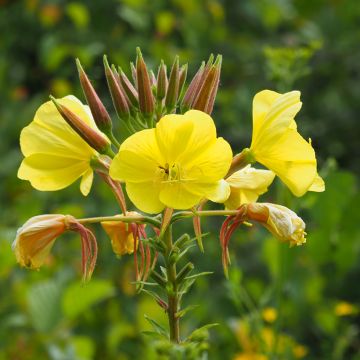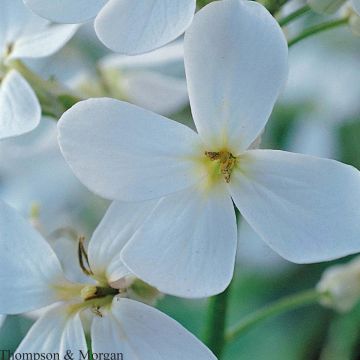

Lagurus ovatus - Hare's Tail
Lagurus ovatus - Hare's Tail
Lagurus ovatus
Hare's Tail, Hare's Tail Grass, Bunny Tails
This item cannot be shipped to the selected country
Dispatch by letter from €3.90
More information
Schedule delivery date,
and select date in basket
This plant carries a 6 months recovery warranty
More information
We guarantee the quality of our plants for a full growing cycle, and will replace at our expense any plant that fails to recover under normal climatic and planting conditions.
Seed-only orders are dispatched by sealed envelope. The delivery charge for seed-only orders is €3.90.
Does this plant fit my garden?
Set up your Plantfit profile →
Description
Lagurus ovatus Bunny Tails, also known as Dwarf Hare's Tail, is a lovely small annual grass. Its small ovoid, white and silky spikes ripen from June to October above a cushion of hairy stems. They are perfect in both pots as well as colourful borders, to which they bring a lot of softness. Undemanding and easy to grow, this plant enjoys sun and soil that is well drained, fresh to dry, or even poor. It offers excellent flowers for dry bouquets.
Lagurus ovatus, commonly called Hare's Tail Grass, is a herbaceous annual plant belonging to the Poaceae family, native to southern Europe and which has now become naturalised in many countries. In the wild, it grows in uncultivated areas, fallow fields, scrubland, and sandy coastal areas. 'Bunny Tails' is a dwarf form, with small cushions composed of hairy and sheathing stems and leaves, not exceeding 25 cm (9.8 in) in all directions. The flowering period is particularly long, from June to October. The tiny flowers are gathered in oval-shaped spikes, 2 to 4 cm (0.8 to 1.6 in) long, with a very soft texture. Initially pale green with iridescent pink-purple-lilac hues, these hairy inflorescences then turn creamy white and flaxen. The medium-green foliage turns flaxen and then golden-brown at the end of the season.
While it is mainly cultivated for dried flowers, this soft and plump 'Hare's Tail Grass' that one cannot help touching has a beautiful effect in borders, where it will lighten them up. Its changing spikes with very soft tones harmonise particularly well with the old roses found in clarkias, agrostemmas, or tall sedums. It will accompany lavenders, echiums, rosemary, catmints, and shrubby salvias in rockeries or dry gardens.
Report an error about the product description
Flowering
Foliage
Plant habit
Botanical data
Lagurus
ovatus
Poaceae
Hare's Tail, Hare's Tail Grass, Bunny Tails
Cultivar or hybrid
Other Flower seeds A to Z
Planting and care
Sow Lagurus ovatus from March to August or in September, at the same time that farmers sow wheat, once winter has passed, but only when the soil has been cleared of all vegetation for at least 2 months. Roughly turn over the soil, ensure good drainage by incorporating coarse sand or gravel, and remove weeds. Bury the seeds at a depth of 0.5 cm (0.2 in), then tamp down with a rake. The ideal temperature for germination is 15-18 °C (59-64.4 °F). Water regularly. Thin out the seedlings, leaving only one plant every 30 cm (11.8 in). This plant should be placed in a sunny position. To bring forward the flowering date, sowing can be done in a mini-greenhouse from March. The resulting plants should be gradually hardened before being planted in open ground. Cut the inflorescences in August and dry them upside down in a dry, well-ventilated room.
Sowing period
Intended location
-
, onOrder confirmed
Reply from on Promesse de fleurs
Flower seeds
Haven't found what you were looking for?
Hardiness is the lowest winter temperature a plant can endure without suffering serious damage or even dying. However, hardiness is affected by location (a sheltered area, such as a patio), protection (winter cover) and soil type (hardiness is improved by well-drained soil).

Photo Sharing Terms & Conditions
In order to encourage gardeners to interact and share their experiences, Promesse de fleurs offers various media enabling content to be uploaded onto its Site - in particular via the ‘Photo sharing’ module.
The User agrees to refrain from:
- Posting any content that is illegal, prejudicial, insulting, racist, inciteful to hatred, revisionist, contrary to public decency, that infringes on privacy or on the privacy rights of third parties, in particular the publicity rights of persons and goods, intellectual property rights, or the right to privacy.
- Submitting content on behalf of a third party;
- Impersonate the identity of a third party and/or publish any personal information about a third party;
In general, the User undertakes to refrain from any unethical behaviour.
All Content (in particular text, comments, files, images, photos, videos, creative works, etc.), which may be subject to property or intellectual property rights, image or other private rights, shall remain the property of the User, subject to the limited rights granted by the terms of the licence granted by Promesse de fleurs as stated below. Users are at liberty to publish or not to publish such Content on the Site, notably via the ‘Photo Sharing’ facility, and accept that this Content shall be made public and freely accessible, notably on the Internet.
Users further acknowledge, undertake to have ,and guarantee that they hold all necessary rights and permissions to publish such material on the Site, in particular with regard to the legislation in force pertaining to any privacy, property, intellectual property, image, or contractual rights, or rights of any other nature. By publishing such Content on the Site, Users acknowledge accepting full liability as publishers of the Content within the meaning of the law, and grant Promesse de fleurs, free of charge, an inclusive, worldwide licence for the said Content for the entire duration of its publication, including all reproduction, representation, up/downloading, displaying, performing, transmission, and storage rights.
Users also grant permission for their name to be linked to the Content and accept that this link may not always be made available.
By engaging in posting material, Users consent to their Content becoming automatically accessible on the Internet, in particular on other sites and/or blogs and/or web pages of the Promesse de fleurs site, including in particular social pages and the Promesse de fleurs catalogue.
Users may secure the removal of entrusted content free of charge by issuing a simple request via our contact form.
The flowering period indicated on our website applies to countries and regions located in USDA zone 8 (France, the United Kingdom, Ireland, the Netherlands, etc.)
It will vary according to where you live:
- In zones 9 to 10 (Italy, Spain, Greece, etc.), flowering will occur about 2 to 4 weeks earlier.
- In zones 6 to 7 (Germany, Poland, Slovenia, and lower mountainous regions), flowering will be delayed by 2 to 3 weeks.
- In zone 5 (Central Europe, Scandinavia), blooming will be delayed by 3 to 5 weeks.
In temperate climates, pruning of spring-flowering shrubs (forsythia, spireas, etc.) should be done just after flowering.
Pruning of summer-flowering shrubs (Indian Lilac, Perovskia, etc.) can be done in winter or spring.
In cold regions as well as with frost-sensitive plants, avoid pruning too early when severe frosts may still occur.
The planting period indicated on our website applies to countries and regions located in USDA zone 8 (France, United Kingdom, Ireland, Netherlands).
It will vary according to where you live:
- In Mediterranean zones (Marseille, Madrid, Milan, etc.), autumn and winter are the best planting periods.
- In continental zones (Strasbourg, Munich, Vienna, etc.), delay planting by 2 to 3 weeks in spring and bring it forward by 2 to 4 weeks in autumn.
- In mountainous regions (the Alps, Pyrenees, Carpathians, etc.), it is best to plant in late spring (May-June) or late summer (August-September).
The harvesting period indicated on our website applies to countries and regions in USDA zone 8 (France, England, Ireland, the Netherlands).
In colder areas (Scandinavia, Poland, Austria...) fruit and vegetable harvests are likely to be delayed by 3-4 weeks.
In warmer areas (Italy, Spain, Greece, etc.), harvesting will probably take place earlier, depending on weather conditions.
The sowing periods indicated on our website apply to countries and regions within USDA Zone 8 (France, UK, Ireland, Netherlands).
In colder areas (Scandinavia, Poland, Austria...), delay any outdoor sowing by 3-4 weeks, or sow under glass.
In warmer climes (Italy, Spain, Greece, etc.), bring outdoor sowing forward by a few weeks.






















































